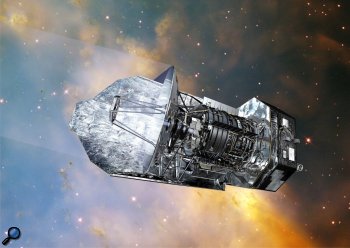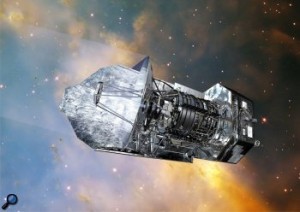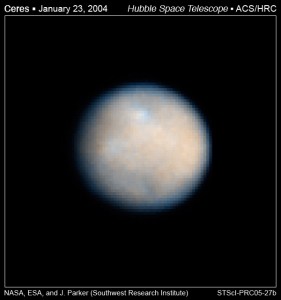January 23, 2014 – The European Space Agency Herschel Space Observatory (see artist rendering below) has detected water vapor on the super-sized asteroid, Ceres. It appears that plumes of water vapor shoot up from its icy surface whenever it warms slightly.
This is a first. Up until now astronomers had speculated that many asteroids were icy bodies or contained large amounts of water ice. Now this speculation is confirmed.
The Dawn mission, NASA’s multi-asteroid robotic voyage that orbited Vesta for more than a year, is on its way now to Ceres to make much closer observations. It should arrive in the spring of next year.
Ceres is 950 kilometers in diameter. When first discovered in 1801 it was named a planet. But that was before many more asteroids were spotted orbiting between Jupiter and Mars. Today it is classified as a dwarf planet along with Pluto and other recently discovered objects within the Oort Cloud that surrounds our Sun beyond Neptune.
Scientists believe Ceres combines a rocky core with a thick ice mantle. The reason water vapor has been detected is believed to be a function of the dwarf planet’s orbit with it currently closer to the Sun. At this position its icy surface is warm enough to allow water vapor to plume from the surface. The scientists have even been able to detect where on its surface the water is coming from. Two dark spots detected by the Hubble Space Telescope are believed to be the source of the water.
Icy plumes have previously been detected on Europa and Enceladus, the former a moon of Jupiter, the latter of Saturn. And icy plumes jetting off comet surfaces have been known for years. Now, for the first time however, we are observing the same phenomenon from an asteroid or dwarf planet.
What this tells us is that, in our Solar System, water is abundant. And where there is water we may find the building blocks of life similar to here on Earth.
The colour image below taken by the Hubble Space Telescope in January 2004, shows both light and darker surface features on Ceres. When Dawn arrives we will learn so much more about this giant of the Asteroid Belt.














[…] Headlines: Water Vapor Detected on the Dwarf Planet Ceres […]